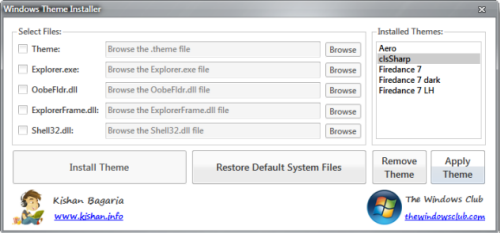Many users, usually the less tech savvy ones, have trouble installing custom themes on Windows. And why not? There are no setup files that you can click through and no button with ‘Install theme’ written on it. Everything needs to be done manually, from patching files to copying folders. For a typical Windows user, it’s too much of work. So if your friend asks you how to do it, just direct them to Windows Themes Installer.
Windows Themes Installer is a new software that helps users apply a theme, remove a theme and restore defaults easily in Windows 7 and Vista.

To install a theme, you will first need to patch the uxtheme.dll file using Universal Theme Patcher, as this function is absent in Windows Themes Installer. Then download the Installer and follow these steps:
- Run the tool as Administrator, by right-clicking on the file and choosing “Run as Administrator”
- Select the options which you want to install:
- Theme
- Explorer.exe
- OobeFldr.dll
- ExplorerFrame.dll
- Shell32.dll
- Once you have selected the options, click on the “Browse” button and browse for the file of the desired option.
- Now click on “Install Theme” button to install the theme and replace the system files.
- Once the theme is installed it will appear under “Installed themes”. Select the theme which you want to apply from the list and click on the “Apply Theme” button.
Don’t worry if the theme pack you downloaded doesn’t contain all the files mentioned under Step2. The downloaded theme pack will certainly contain the .theme, which is the actual theme file. The rest make further modification to the system and you may choose not to install them. However, these are required if you want to make a complete makeover of Windows.
Get Windows Vista and Windows 7 themes.
[via The Windows Club]

Comments
Post a Comment